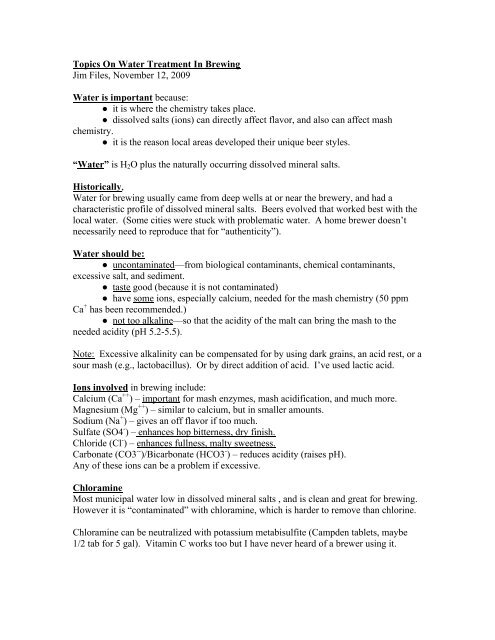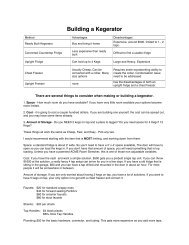2009-11-12 Topics on Water Treatment - Bay Area Mashers
2009-11-12 Topics on Water Treatment - Bay Area Mashers
2009-11-12 Topics on Water Treatment - Bay Area Mashers
- No tags were found...
You also want an ePaper? Increase the reach of your titles
YUMPU automatically turns print PDFs into web optimized ePapers that Google loves.
<str<strong>on</strong>g>Topics</str<strong>on</strong>g> On <strong>Water</strong> <strong>Treatment</strong> In BrewingJim Files, November <str<strong>on</strong>g>12</str<strong>on</strong>g>, <str<strong>on</strong>g>2009</str<strong>on</strong>g><strong>Water</strong> is important because:● it is where the chemistry takes place.● dissolved salts (i<strong>on</strong>s) can directly affect flavor, and also can affect mashchemistry.● it is the reas<strong>on</strong> local areas developed their unique beer styles.“<strong>Water</strong>” is H 2 O plus the naturally occurring dissolved mineral salts.Historically,<strong>Water</strong> for brewing usually came from deep wells at or near the brewery, and had acharacteristic profile of dissolved mineral salts. Beers evolved that worked best with thelocal water. (Some cities were stuck with problematic water. A home brewer doesn’tnecessarily need to reproduce that for “authenticity”).<strong>Water</strong> should be:● unc<strong>on</strong>taminated—from biological c<strong>on</strong>taminants, chemical c<strong>on</strong>taminants,excessive salt, and sediment.● taste good (because it is not c<strong>on</strong>taminated)● have some i<strong>on</strong>s, especially calcium, needed for the mash chemistry (50 ppmCa + has been recommended.)● not too alkaline—so that the acidity of the malt can bring the mash to theneeded acidity (pH 5.2-5.5).Note: Excessive alkalinity can be compensated for by using dark grains, an acid rest, or asour mash (e.g., lactobacillus). Or by direct additi<strong>on</strong> of acid. I’ve used lactic acid.I<strong>on</strong>s involved in brewing include:Calcium (Ca ++ ) – important for mash enzymes, mash acidificati<strong>on</strong>, and much more.Magnesium (Mg ++ ) – similar to calcium, but in smaller amounts.Sodium (Na + ) – gives an off flavor if too much.Sulfate (SO4 - ) – enhances hop bitterness, dry finish.Chloride (Cl - ) – enhances fullness, malty sweetness.Carb<strong>on</strong>ate (CO3 -- )/Bicarb<strong>on</strong>ate (HCO3 - ) – reduces acidity (raises pH).Any of these i<strong>on</strong>s can be a problem if excessive.ChloramineMost municipal water low in dissolved mineral salts , and is clean and great for brewing.However it is “c<strong>on</strong>taminated” with chloramine, which is harder to remove than chlorine.Chloramine can be neutralized with potassium metabisulfite (Campden tablets, maybe1/2 tab for 5 gal). Vitamin C works too but I have never heard of a brewer using it.
Chloramine can be removed by filtrati<strong>on</strong> through a granular activated carb<strong>on</strong> (GAC)filter. Use a filter specifically intended chloramine, since the typical water filter(designed to remove lead, toxins, rust, etc) w<strong>on</strong>’t get rid of the chloramine! I useCulligan D-28 filter. Lots of brewers d<strong>on</strong>’t bother to remove chloramine. So ask aroundand decide for yourself.Brewing SaltsAdditives (salts) sometimes used include:Gypsum (CaSO 4 )Calcium Chloride (CaCl 2 )Epsom Salts (MgSO 4 )Table Salt (not iodized) (NaCl)Chalk (CaCO 3 )“Burt<strong>on</strong> salts” is a mixture, mostly gypsum.East <strong>Bay</strong> MUD districts (as well as SF, the peninsula and Marin) have soft water. Verysoft water is not ideal, except in maybe in Pilzen. The annual EBM water report is <strong>on</strong>line.http://www.ebmud.com/water_&_envir<strong>on</strong>ment/water_quality/annual_report/2008_annual_water_quality_report.pdfCalcium level in the Berkeley/Oakland/Alameda regi<strong>on</strong> water ranges from 4 to 20 ppm(parts per milli<strong>on</strong>).George Fix, in Principles of Brewing Science, 2 nd editi<strong>on</strong>, 1999. page 6, says “A widelyaccepted rule in brewing is to have calcium c<strong>on</strong>centrati<strong>on</strong>s of at least 50 mg/L (ppm) andvalues in the range of 100-150 mg/L are very comm<strong>on</strong>.”By my calculati<strong>on</strong>s 5 grams CaSO4 (around 1 tsp.) c<strong>on</strong>tributes 60 ppm Calcium to 5gall<strong>on</strong>s, and 5 grams CaCl2 (around 1 tsp.) c<strong>on</strong>tributes 70 ppm Calcium to 5 gall<strong>on</strong>s.THE BOTTOM LINEI usually add 1 tsp. Calcium Chloride or Calcium Sulfate (gypsum) to my mash. I useCalcium Chloride to accentuate malty sweetness. I use Calcium Sulfate (gypsum) whenI want a hop accentuated beer. For “Burt<strong>on</strong>” style, use 2-3 tsp. gypsum.Is it worth bothering to remove chloramine? Ask the best brewer you know.





